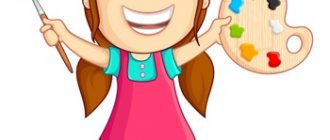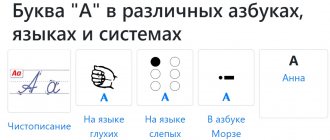Dyslexia begins to manifest itself most clearly in primary school.
At the age of 7-8 years, a child cannot cope with mastering reading skills. He confuses syllables, composes words slowly, and even if he can read a sentence, he cannot understand the meaning of what is being said. At the same time, the student is distinguished by a normal level of mental development and a rich imagination. Experts say that early treatment of dyslexia can eliminate the pathology or, at a minimum, help the child successfully cope with its manifestations. The disease is treated by a speech therapist or defectologist with a narrow specialization, but the therapeutic process must take place in close cooperation with the baby’s parents.
If your younger student has obvious difficulties in mastering reading skills or is at increased risk of developing this deviation, then the tasks and exercises presented below will suit you perfectly. They will help the student develop logical thinking and abstract concepts, develop reading and perception skills, and also increase concentration.
Articulation gymnastics
You should start your classes with warm-up exercises:
- inhale through the nose and exhale through the mouth;
- inhale - hold your breath for a few seconds - exhale;
- We take an incomplete breath and do not exhale the air completely.
This is followed by exercises that develop clarity and intelligibility of pronunciation. The child is asked to complete phrases with associative sounds:
- a fly flies around the room “z-z-z”;
- the dog growls at the cat “rrrr”;
- a snake crawls in the grass “sh-sh-sh”;
- a bumblebee lands on a flower “w-w-w”;
- a horse runs across the field “clack-clack-clack”, etc.
Take a deep breath and, on one exhale, read all the consonants in the line:
- KNSHLZZTSSBTMPVCHF;
- VMRGKTBDZSHCHZBCHVN;
- VDGBFKZRChPTKZRM;
- ChMKPBRVSFSHMZHDSHH.
Read the phrases slowly and clearly:
- ru-ru-ru - the keguru ran away;
- you-you-you - the cats meowed;
- chi-chi-chi - all the balls rolled.
Read in a whisper at a moderate pace:
- arna – arla;
- arzha – arch;
- arla – arma;
- arba - harp.
Read out loud and as quickly as possible:
- burn – oven – lie down;
- door – worm – beast;
- chalk - stake - silt;
- fry - steam - burn.
Read aloud tongue twisters, sayings and proverbs:
- as is the fiber, so is the linen;
- whether they watered the lily, whether they saw Lydia;
- the ships tacked, tacked, but did not tack;
- Geese cackle on the mountain, a fire burns under the mountain;
- our duda is both here and there.
Game "What's in the chest?"
For this exercise you need to make three-dimensional letters of the alphabet. They can be made from plasticine, clay, or cut out of hard cardboard. The lettering material is placed in a box or opaque bag. The child is offered several options for this game:
- It is necessary, without taking it out of the box, to identify the letter of the alphabet by touch and describe it. After this, take out the letter, make sure the answer is correct and make words with it. You can make the task more difficult by requiring that this particular letter be at the beginning, end, or middle of the word the child comes up with.
- The box contains letters that can be used to form several short words. The child takes out the letters, completes the task, and then comes up with sentences with the solved word.
Kornev's technique
Kornev’s method for eliminating dyslexia is based on early diagnosis of pathology using tests. For example, the child must name objects in order and say their purpose, repeat the movements after the teacher, repeat the rhythm, identify the left and right arm/leg. The same exercises are used in classes to correct dyslexia.
The author has developed a technique that includes selecting an individual learning pace, monitoring new skills, and using a game form of learning.
Game "ladder"
The child is asked to read words with different numbers of syllables, which are arranged in the form of a ladder: HEDGEHOG CANCER HIS LUM HORSE GIRL PRESIDENT GEAR SILKY
In this case, the student needs to complete several tasks:
- read the words located in the “ladder” from top to bottom;
- If you come across an incomprehensible word, you should find out what it means and read it several times;
- if the word is difficult to read in its entirety, it is necessary to divide it into syllables or letters, and then combine it into one whole;
- read the “ladder” from bottom to top.
Factors that aggravate the situation with dyslexia:
1. Weak language skills and speech problems : late (less often early) onset of one’s own speech; characterized by bright turns of speech; deficiencies in phonetics; difficulty expressing thoughts in words; stuttering.
2. Problems with mastering writing skills : difficulties in writing words; reversal (mirror writing) of letters and numbers; a large number of errors when copying and writing from dictation; bad handwriting; there are many corrections in written works; combined with dysgraphia and dysorthography.
3. Weak math skills: learning difficulties; difficulty estimating time; may be able to perform arithmetic operations, but not the ability to write or read them; problems with algebra or higher mathematics, but may also be successful in the subject; poor memory for sequences.
4. Psychological difficulties and problems : low academic performance; insufficient formation of visual memory; low speed of completing tasks and inability to meet the deadline allocated for completing the task; emotional instability – excessive emotionality or irritability; difficulty concentrating, including on one activity; problematic switching between different types of activities; loss of interest, lack of self-confidence; high level of anxiety and fear of mistakes, can be assessed as a lazy student; Doesn't do well on tests despite having a high IQ.
5. Motor and psychomotor difficulties : may have poor handwriting; disorders of spatial orientation, visual-motor coordination, clumsiness, clumsiness, disturbances of interhemispheric interaction; impaired coordination of movements and the associated assimilation of knowledge - a violation of the assimilation of the body diagram, confuses “right” - “left” and “above” - “under”; lags behind in team sports, has difficulty with motor-oriented tasks, learns best through hands-on experience.
6. Neurological problems : often dizziness, headache, stomach pain; behavior may be erratic or disruptive; urinary incontinence even beyond the appropriate age; a sharp increase in difficulties under time pressure and stress.
7. Vision problems: complaints of vision problems that are not detected during standard examinations; there may be a disturbance in depth perception; defects in peripheral vision.
The listed factors can be combined or isolated, characteristic only of dyslexia.
Sometimes it seems that skills are “mood dependent” and change from day to day. A child with dyslexia can easily read and write a word today, and just as easily fail to do so tomorrow.
Also, children with dyslexia are characterized by variability in errors: the same word can be read both correctly and incorrectly, and the erroneous reading looks different with each attempt: “dig - dig - roll - guess.”
Memorizing graphic expressions of words
Each star has a specific syllable written on it. It is necessary to compose words and circle them with multi-colored pencils (for example, crow, textbook, carpet, alphabet, teacher, etc.).
The second version of the exercise, or the game “Treasure Island”. The child needs to get to the treasure chest by making up words from the syllables written under the small islands. The composed words should be painted in different colors (for example, jungle, islands, etc.).
In order to improve perception and supplement the associative series, you can supplement the task with cards depicting the words that the child composes.
Prevention measures
An important component of prevention is competent planning of pregnancy, prevention of complications of pregnancy and childbirth, traumatic brain injuries during childbirth and in the future. This will prevent brain dysfunction, which is the main cause of dyslexia.
The next method of preventing dyslexia is to develop visuospatial functions, memory, attention, fine motor skills, and analytical abilities. You need to communicate more with your baby: in everyday life, during classes. The development of spoken language plays a big role in preventing and overcoming dyslexia. Learning songs, stories, poems will help improve writing and reading skills. Read books with discussion of what you read or listen to audio books.
It is important to exclude ophthalmological pathology and diseases of the hearing organ. Impaired auditory and visual perception can cause dyslexia.
Regular testing is recommended for children at risk. This will allow timely identification of speech disorders and begin their correction.
Sea battle game
The exercise is aimed at improving the skills of analysis and synthesis of syllables, as well as the formation of the student’s vocabulary. The child is provided with a playing field with pictures of ships. Syllables are written on each drawn boat. An adult needs to name the coordinates of a sea vessel on the field, and a schoolchild needs to find the right cell and write out the syllable indicated in it. By finding the boats in the correct order, the student will be able to form words from the written syllables.
For example:
- (E5, B6) buh – that: bay;
- (D3, I8) beech – sire: tug;
- (B2, G10) pa – rum: steam;
- (G2, Z7, Z3) ko – slave – whether: ships;
- (D7, A9, E1) ka-pi-tan: captain.
Training according to Zhukova
In this article, we will describe the basic principles of a well-known and already proven effective method of teaching a child with dyslexia to read. Its author is Nadezhda Sergeevna Zhukova, speech therapist and experienced teacher.
Her book, a special primer for dyslexics, has helped thousands of children master reading and writing.
The essence of the program is a combination of new techniques (in a game form) and traditional techniques. Thanks to her, children not only learn the alphabet, but also learn to understand what they read, speak correctly, and then read fluently and out loud.
Zhukova's primer contains short exercises with funny pictures. They teach in a playful way, do not tire, but rather entertain. The lessons become more difficult gradually. Much attention is paid here to the process of merging two letters into one syllable, as well as merging syllables into words.
That is, precisely the factor that is given to dyslexic children with great difficulty. It is important that the book also contains advice for parents and important additional recommendations.
When should you start exercising? Everything is very individual. If the diagnosis of dyslexia has already been made, and there are problems with reading and the alphabet, then you can start learning - at 5 years old or 6 years old, it doesn’t matter so much.
It is imperative to teach a first grader.
The signal to start learning is a boy or girl’s intense interest in books. If he asks to read to him, looks at the pictures, is interested in the content, asks questions, then it’s time to start!
Working on establishing correct word order
The task is aimed at improving the student’s understanding of the text he is reading. The task is to make sentences in accordance with the picture. The child needs to correctly fill in the blanks when describing the image. At the same time, it is important to ensure that the word order is correct and the sentences are constructed correctly.
The girl is riding. _______ _______ on _______. _______ _______ on _______ in_______. _______ _______ on _______ in _______ and ________.
Systematic implementation of such game exercises helps the student cope with the difficulties that arise when mastering reading skills. Dyslexics significantly improve their reading technique and quality, improve their skills in working with textual material, and also increase their self-esteem and self-confidence. At the same time, it is important to remember that only a specialist can correctly correct dyslexia, who will select the most suitable types of work and exercises for a particular form of the disease.
Publication date: 05/06/2019. Last modified: 11/29/2021.
Davis technique
The author of the method for eliminating dyslexia, Ronald D. Davis, was of the opinion that the basis of dyslexia is disorientation in space, in the perception of time, hearing and vision. Therefore, to overcome dyslexia, they need to develop the skill of controlling disorientation and eliminating the causes of this phenomenon.
Controlling disorientation is achieved by teaching techniques to help the child determine when he is disoriented. This is an understanding of what is happening, for example, the patient evaluates the situation from the outside, as an observer, and analyzes and draws a conclusion. The student begins to become aware of himself in space, and in the future he will begin to adequately perceive letters and words.






